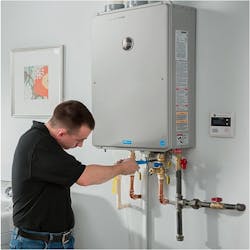Ocean Commons, a new housing development in Surfside Beach, S.C., faced a challenge when the natural gas lines from the local utility reached capacity, halting all further development and home construction. To keep the the project moving required a transition from natural gas to onsite propane.
For builders who are used to working with natural gas, the thought of transitioning to propane may seem daunting, but the process is quite seamless and simple.
Key Differeces Between Natural Gas and Propane
The primary difference is the storage and delivery method of the two energy sources. Unlike natural gas, which relies on continuous pipeline infrastructure, propane is stored onsite in tanks. Determining the tank capacity to support the home’s energy demands and and its placement within on each lot requires skilled planning before construction begins.
In addition, propane requires only slight changes to the home’s piping and regulator systems compared with natural gas because it operates at a higher pressure. Also, propane lines run directly to each appliance it serves.
Propane professionals and licensed installers are highly trained in the installation, selection of the correct tank size, and specific piping materials and regulators needed to maintain a safe and efficient operation.
When converting a home's existing appliances from natural gas to propane, builders need to consider appliance compatibility. If the appliances were originally designed for natural gas, builders will need to confirm whether those units are capable of a dual-fuel operation.
Dual-fuel appliances can be converted to propane by using specialized conversion kits, which include orifices, regulators, and burner air shutters tailored to propane’s higher pressure specifications.
For appliances not compatible with dual-fuel conversion, builders will have to source propane-specific models to ensure safe and reliable performance.
High-Quality, Smart Features
At the Ocean Commons properties, in partnership with Ameri-Built Homes, new, semi-custom homes were all specified to be turnkey with smart technology and energy-efficient features. Thanks to the ease of transitioning from natural gas to propane, builders can keep that promise to their customers.
A standout feature in these homes high-efficiency tankless water heaters, which provide on-demand hot water so homeowners never have to choose between a hot shower, running the dishwasher, or doing a load of laundry.
Tankless water heaters can also be equipped with “smart” recirculation, a feature that learns usage patterns to deliver hot water exactly when needed instead of wasting water while it heats up (also called “lag time”). This feature also extends the life of the water heater by up to twice as long as a traditional tank unit.
Homeowners also experience long-term cost benefits, as propane-fueled tankless water heaters can cost up to $100 less annually to operate than standard electric storage models.
Located just a mile from the beach, homes at Ocean Commons also benefit from propane being a clean energy source that won’t harm the coastal environment. Propane produces fewer greenhouse gas emissions than many traditional fuels, is non-toxic, and won’t contaminate soil or water.
A recent study by the Propane Education & Research Council (PERC) found that homes with propane-powered appliances reduced household carbon dioxide emissions by an average of 35%.
About the Author

Bryan Cordill
Bryan Cordill is director of residential and commercial business development for the Propane Education & Research Council. He can be reached at [email protected]. To learn more about the benefits of residential propane applications, visit the council's website.

